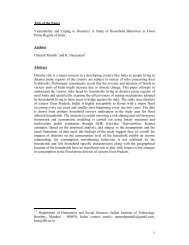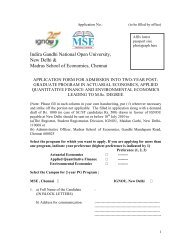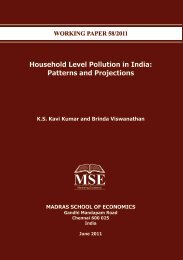Envisage - News Letter-March - Madras School of Economics
Envisage - News Letter-March - Madras School of Economics
Envisage - News Letter-March - Madras School of Economics
Create successful ePaper yourself
Turn your PDF publications into a flip-book with our unique Google optimized e-Paper software.
<strong>Madras</strong> <strong>School</strong><br />
<strong>of</strong> <strong>Economics</strong><br />
(Centre <strong>of</strong> Excellence in<br />
Environmental <strong>Economics</strong>)<br />
<strong>News</strong>letter<br />
ENVIS CENTRE ON ENVIRONMENTAL ECONOMICS<br />
ENVISAGE<br />
Volume 4, No. 2, February 2007<br />
Editorial Team<br />
Dr. Paul P. Appasamy<br />
Member Secretary<br />
Centre <strong>of</strong> Excellence<br />
Dr. K.S. Kavi Kumar<br />
Associate Pr<strong>of</strong>essor<br />
Dr. Kakali<br />
Mukhopadhyay<br />
Assistant Pr<strong>of</strong>essor<br />
Technical Assistance<br />
S.H. Faizal Rustham<br />
Jr. Environmental Economist<br />
A. Revathy<br />
Web Programmer<br />
Contents<br />
T r a d e a n d<br />
Environment: A<br />
Study <strong>of</strong> India's<br />
Leather Exports<br />
<br />
<br />
<br />
<br />
<br />
Trade Liberalization<br />
and the Environment:<br />
With Special<br />
Reference to the<br />
Tiruppur Textile<br />
Cluster<br />
E-Waste<br />
Management<br />
Specific Trade<br />
Obligations in MEA<br />
Web resources on<br />
T r a d e a n d<br />
Environment<br />
MSE <strong>News</strong><br />
<strong>Madras</strong> <strong>School</strong> <strong>of</strong> <strong>Economics</strong><br />
Gandhi Mandapam Road<br />
Chennai-25.<br />
Phone: 044-22300304<br />
Fax: 044-22354847<br />
E-mail: envis@mse.ac.in<br />
Web: http://coenvis.mse.ac.in<br />
Editorial<br />
Trade liberalization has led to the rapid growth <strong>of</strong> certain industries like<br />
leather and textiles, which are also highly polluting. The discharge <strong>of</strong> partially<br />
treated effluents into land and water has caused serious environmental<br />
damage. The first article by Pr<strong>of</strong>.U Sankar explores various dimensions <strong>of</strong> trade<br />
and environment in the context <strong>of</strong> the Indian leather industry. The study<br />
commissioned the Ministry <strong>of</strong> Environment and Forests has been published as a<br />
book by Oxford University Press. The second article raises similar issues with<br />
regard to the textile industry in Tiruppur.<br />
Trade in wastes is now regulated by international chemical conventions.<br />
Dr. Kakali Mukhopadhyay discusses the rapidly growing problem <strong>of</strong> electronic<br />
wastes which are now being exported to developing countries in Asia. An Expert<br />
Group has come out with Compendiums and Background papers on the specific<br />
trade obligations contained in the major Multilateral Environmental<br />
Agreements. This document will be <strong>of</strong> use to policy makers, researchers and<br />
others who are interested in the trade related aspects <strong>of</strong> MEA's. The Ministry <strong>of</strong><br />
Environment and Forests has also set up a Programme on Trade and<br />
Environment at MSE under the guidance <strong>of</strong> Pr<strong>of</strong>. U. Sankar. The programme will<br />
continue to provide policy assistance to the Ministry in this important area.<br />
This is the last issue <strong>of</strong> ENVISAGE in the Tenth Plan period. We are grateful<br />
to the Ministry <strong>of</strong> Environment and Forests for funding the ENVIS Centre on<br />
Environmental <strong>Economics</strong>, which made it possible for the Centre to bring out<br />
this newsletter over the last five years.<br />
Programme on Trade and Environment<br />
The Ministry <strong>of</strong> Environment and Forests, Government <strong>of</strong> India has<br />
sanctioned a three-year consultancy Project, 'Programme on Trade and<br />
st<br />
Environment' from 1 December 2006.<br />
The objectives <strong>of</strong> the Programme are:<br />
(i)<br />
(ii)<br />
(iii)<br />
Provide technical inputs to the preparatory process at the MoEF in<br />
the area <strong>of</strong> trade and environment, in particular, items under<br />
negotiations in the WTO and other multilateral, regional and<br />
bilateral trade agreements.<br />
Examine the linkages between trade and environment with special<br />
reference to the priority sectors <strong>of</strong> the MoEF, and<br />
Assess the likely impact <strong>of</strong> proposed changes in the WTO policies in<br />
the affected sectors and suggest suitable strategies and policy<br />
recommendations.<br />
Dr. U. Sankar is the Coordinator <strong>of</strong> the Project.
Trade and Environment<br />
A Study <strong>of</strong> India's Leather Exports*<br />
Motivation for the Study<br />
The 1990s witnessed far-reaching developments<br />
in world trading and environmental policy regimes,<br />
requiring actions at global and national levels. It was<br />
anticipated that trade liberalization would yield<br />
significant gains from trade for developing countries,<br />
which possess comparative advantage in production<br />
<strong>of</strong> natural resource- intensive and labour-intensive<br />
products. But as most <strong>of</strong> the units are in cottage and<br />
small-scale sectors, and as they lack modern/clean<br />
technologies, they face difficulties in complying with<br />
domestic environmental regulations. Now, these<br />
units fear that stringent environmental requirements<br />
abroad will affect access <strong>of</strong> their products in foreign<br />
markets. The leather industry had been chosen for an<br />
in-depth study as it was perceived to be a highly<br />
polluting industry, and leather and leather products<br />
identified as a thrust sector for export promotion by<br />
the Government <strong>of</strong> India.<br />
Trade and Environment Linkages<br />
The study reviews the evolution <strong>of</strong> the<br />
multilateral trading system and special provisions in<br />
the World Trade Organization dealing with<br />
environmental concerns. It shows that trade<br />
liberalization with a sound domestic environmental<br />
policy regime can enhance welfare <strong>of</strong> developing<br />
countries. But if environmental standards abroad are<br />
more stringent than domestic environmental<br />
standards, then the anticipated gains from trade<br />
liberalization would not occur. It considers the issue<br />
<strong>of</strong> cross-country differences in environmental<br />
standards and their impact on trade from the<br />
perceptions <strong>of</strong> both developed and developing<br />
countries. It also reiterates the need for<br />
implementing the special provisions agreed upon at<br />
the UN Conference on Environment and Development<br />
1992 and the WTO so that the world trading regime<br />
benefits developing countries.<br />
Environmental Requirements Abroad<br />
The environmental requirements in the European<br />
Union and the United States include product<br />
specifications, limits prescribed for restricted<br />
substances, test methods for these substances,<br />
packaging requirements, customer requirements,<br />
eco-labeling and ISO and other certification<br />
requirements. The discharge limits for treated<br />
tannery effluents in France and Italy are more<br />
stringent than the ones in developing countries.<br />
These requirements have the potential <strong>of</strong> being<br />
turned into non-tariff barriers.<br />
Global Leather Industry Supply chain<br />
This study analyzes temporal and cross-country<br />
changes in the global leather industry supply<br />
chain from stocks <strong>of</strong> bovine animals, sheeps and<br />
goats to manufacture <strong>of</strong> leather products. The<br />
relative shares <strong>of</strong> developed and developing<br />
countries by major stage <strong>of</strong> production and country<br />
groups, in production, exports, imports and<br />
availability have been estimated and changes<br />
detected. This study provides some empirical<br />
evidence on “pollution haven” and “race to the<br />
bottom” hypotheses. Case studies <strong>of</strong> Brazil, China<br />
and Italy show how these countries had responded in<br />
different ways to the challenges <strong>of</strong> trade liberalization<br />
and domestic and global environmental<br />
requirements.<br />
Indian Leather Industry Supply Chain<br />
India's shares in the world stocks <strong>of</strong> bovine<br />
animals, sheeps and goats in 2001 were 20.6 percent,<br />
5.6 percent and 16.8 percent respectively. India's<br />
share in the world production <strong>of</strong> bovine hides was<br />
only 12.8 percent. India's share in the world exports<br />
<strong>of</strong> leather and leather products was only 3 percent.<br />
This study considers the supply side problems at<br />
different stages <strong>of</strong> leather production and indicates<br />
* A project funded by the Ministry <strong>of</strong> Environment and Forests under its Centre <strong>of</strong> Excellence in Environmental economics Programme at<br />
<strong>Madras</strong> <strong>School</strong> <strong>of</strong> <strong>Economics</strong>. The Principal Investigator is U. Sankar. The other contributors are: A. Sahasranamam, S. Jawahar, M.<br />
Ramachandran, S. Tholkappian, Mamatha Rao and B. Preethi. For details see U. Sankar, Trade and Environment A study <strong>of</strong> India's Leather<br />
Exports, Oxford University Press, New Delhi, 2006.<br />
2
the potentials for augmenting the supplies at each<br />
stage. It also assesses the impact <strong>of</strong> recent changes<br />
in industrial policies, technological upgradation<br />
programmes, and role <strong>of</strong> foreign direct investment<br />
and joint ventures on the industry's growth<br />
prospects.<br />
Finished Goat leather<br />
Preparedness <strong>of</strong> the Indian Leather Industry<br />
This study examines the legal and regulatory<br />
framework for compliance with domestic<br />
environmental requirements. It contains information<br />
on the economic costs <strong>of</strong> compliance with the existing<br />
environmental regulations. The pollution abatement<br />
cost, as percentage <strong>of</strong> the average price <strong>of</strong> finished<br />
leather in 2000-01, varied between 0.86 to 2.35<br />
depending on location and abatement method; the<br />
abatement cost as percent <strong>of</strong> the conversion cost<br />
varied between 1.89 and 5.17 percent.<br />
The<br />
percentage share in the average price <strong>of</strong> wet blue<br />
leather varied between 1.35 and 3.69, and the share<br />
in the conversion cost varied between 3.20 and 8.60.<br />
The industry's response to the domestic global<br />
environmental requirements is also discussed.<br />
Leather Workshop<br />
India's Leather Exports<br />
This study reviews India's trade policy with<br />
special reference to the leather industry. It analyzes<br />
the trends and changes in the composition and<br />
direction <strong>of</strong> India's leather exports. In 2003, export<br />
<strong>of</strong> leather accounted for one-fourth <strong>of</strong> the value <strong>of</strong><br />
total leather exports and exports <strong>of</strong> leather footwear<br />
accounted for one-fourth <strong>of</strong> the value <strong>of</strong> total leather<br />
exports. Leather goods and leather garments had<br />
shares <strong>of</strong> 18 percent and 14 percent respectively.<br />
India's shares in world exports in 2002 were 3.1 for<br />
leather, 1.35 for leather footwear, 4.96 for leather<br />
goods and 6.25 for leather garments. The major<br />
factors influencing India's leather exports are tariff<br />
escalation in the importing countries, compliance<br />
with domestic and global environmental<br />
requirements, slow progress in modernization /<br />
technological upgradation, and competition from<br />
China, Indonesia and Thailand.<br />
Leather Goods Shop<br />
Perceptions <strong>of</strong> Leather Exporters<br />
A survey <strong>of</strong> 70 <strong>of</strong> the top 100 leather exporters,<br />
conducted in 2003-04, gives information on the<br />
extent <strong>of</strong> their awareness <strong>of</strong> the environmental<br />
requirements, the problems they face in complying<br />
with these requirements, transaction costs<br />
associated with the exports, and their views on the<br />
roles <strong>of</strong> government, industry associations and<br />
technical institutions in creating an enabling<br />
environment to boost leather exports.<br />
The Export Target<br />
The Foreign Trade Policy 2004-09 aims at<br />
doubling the share <strong>of</strong> India's leather exports in the<br />
world leather exports by 2008-09. With the Indian<br />
3
share in the global exports at 2.5 percent in 2003-04<br />
and world exports growing at a compound annual<br />
growth rate (CAGR) <strong>of</strong> 4.0 percent, to achieve a 5<br />
percent share in the world exports in 2008-09, our<br />
export must grow at a CAGR <strong>of</strong> 19.3 percent. The<br />
share <strong>of</strong> domestic sales in the value <strong>of</strong> leather<br />
production in 2003-04 is estimated at 43 percent. If<br />
we assume a CAGR in domestic demand <strong>of</strong> 6.0<br />
percent than the value <strong>of</strong> production in 2008-09 must<br />
be 91.2 percent above the 2003-04 value to meet<br />
both domestic and export demand.<br />
What needs to be done?<br />
The responses <strong>of</strong> key players - firms industry<br />
associations, regulators and government - to the<br />
increasingly stringent environmental requirements at<br />
home and abroad have been reactive rather than<br />
proactive. Even though India possesses the technical<br />
expertise for pollution prevention and control in<br />
tanning, this knowledge is yet to be disseminated and<br />
utilized by tanneries. Sahasranamam documents the<br />
current technology status in tanning by stage <strong>of</strong><br />
processing, availability <strong>of</strong> cleaner technologies /<br />
processes, their costs and benefits in terms <strong>of</strong> cost<br />
savings, better products and improved environmental<br />
quality. There are many domestic policy options for<br />
augmenting the quantity and quality at each stage in<br />
the supply chain. This study suggests measures to<br />
increase the quantity <strong>of</strong> hides and skins availability by<br />
40 percent and increase in their value by 60 percent in<br />
the next five years.<br />
This book suggests measures to improve the<br />
design and performance <strong>of</strong> common effluent<br />
treatment plants (CETPs). It recommends<br />
modifications in the designs for recovery and reuse <strong>of</strong><br />
water and materials, introduction <strong>of</strong> incentive-based<br />
cost-sharing mechanism, and exploration <strong>of</strong> the<br />
feasibility <strong>of</strong> combined treatment <strong>of</strong> tannery effluents<br />
and municipal waste water in tannery towns. It<br />
favours a shift from criminal law to civil law to enable<br />
introduction <strong>of</strong> economic instruments such as<br />
pollution charges and penalties proportional to the<br />
extent <strong>of</strong> violations.<br />
India must pursue a proactive policy in the WTO<br />
negotiations on tariffs, particularly tariff escalation,<br />
technical barriers to trade, and sanitary and<br />
phyto-sanitary agreements. India must also urge the<br />
effective implementation <strong>of</strong> Agenda 21 principles<br />
such as common but differentiated responsibilities<br />
and relative capabilities, transfer <strong>of</strong> environmentally<br />
sound technologies at concessional prices to<br />
developing countries, and international help in<br />
capacity building to cope up with the requirements <strong>of</strong><br />
multilateral agreements on trade and environment.<br />
The study concludes that India's comparative<br />
advantage in the raw materials, skilled labour and<br />
technological know-how are relatively large<br />
compared with the environmental compliance costs.<br />
A pro-active policy can help not only in realizing the<br />
export target but also in achieving the goal <strong>of</strong><br />
sustainable development.<br />
Pr<strong>of</strong>. U. Sankar<br />
<strong>Madras</strong> <strong>School</strong> <strong>of</strong> <strong>Economics</strong><br />
usankar@mse.ac.in<br />
Dissemination Paper Series<br />
The Centre <strong>of</strong> Excellence in Environmental <strong>Economics</strong>, <strong>Madras</strong> <strong>School</strong> <strong>of</strong> <strong>Economics</strong> posted two more<br />
dissemination papers on Centre's Website (http://coe.mse.ac.in). The authors welcome feedback on the<br />
papers from the readers. Feedback can also be sent to the Centre's Member Secretary at<br />
paulappasamy@mse.ac.in<br />
Title<br />
Author<br />
Hedonic price method - A Concept Note<br />
Dr. G.S. Haripriya<br />
Public Disclosures: Using Information<br />
Dr. Vinish Kathuria<br />
to reduce pollution - A Concept Note<br />
4
Trade Liberalization and the Environment<br />
With Special Reference to the Tiruppur Textile Cluster<br />
Introduction<br />
The Indian textile sector witnessed substantial<br />
growth in exports after the liberalization <strong>of</strong> the<br />
economy. Simultaneously, some <strong>of</strong> the textile clusters<br />
also experienced severe environmental problems due<br />
to untreated effluents and hazardous waste. The<br />
Tiruppur cluster is a good example <strong>of</strong> the<br />
environmental problems which have followed trade<br />
liberalization in the textile industry.<br />
Diversification <strong>of</strong> World Textile Trade and<br />
its Implication in India<br />
During the last few decades, substantial global<br />
shifts have occurred in textile production and export.<br />
Before 1980, countries like Germany, Italy, France,<br />
UK, The Netherlands, and USA played a vital role in<br />
world textile and clothing exports. But by 1995, the<br />
dominance <strong>of</strong> these countries had substantially<br />
reduced and the share <strong>of</strong> developing nations,<br />
especially the Asian countries like China, Korea,<br />
Taiwan, India, Pakistan and Thailand has increased<br />
(Dicken, 1998). The main factor attributed to this<br />
shift is the cheap labour cost in developing nations<br />
compared to the western countries. The<br />
environmental policies, which are relatively liberal in<br />
developing nations, might also have contributed to<br />
the shift in textile manufacturing.<br />
During the post liberalization period <strong>of</strong> the Indian<br />
economy, the cotton textile and garment industries<br />
grew rapidly. These industries generated substantial<br />
employment, income, and foreign exchange. The<br />
percentage <strong>of</strong> textiles in the total exports from India<br />
doubled from 17 per cent (1981-82) to 31.6 per cent<br />
(1998-1999). At present the textile industry accounts<br />
for about 14 per cent <strong>of</strong> the national industrial<br />
production and about 4 per cent <strong>of</strong> GDP. It provides<br />
employment opportunities to 35 million people,<br />
particularly in the rural and remote areas <strong>of</strong> the<br />
country. Recently, the Indian textile sector has been<br />
experiencing structural transformation through the<br />
reduction in the role <strong>of</strong> the organized mill sector and<br />
an increase <strong>of</strong> the small scale and cottage sectors<br />
(handlooms, power loom, knitwear and garment<br />
making units) with high export potential. These<br />
sectors are developing in a highly decentralized and<br />
flexible industrial networking manner as clusters. To<br />
some extent, the industrial policy adopted by the<br />
Government <strong>of</strong> India, which emphasized the growth<br />
<strong>of</strong> small-scale industries, has also favoured the<br />
growth <strong>of</strong> textile industries as clusters.<br />
Environmental Management and Eco-labeling<br />
The wet processing (bleaching and dyeing)<br />
segment <strong>of</strong> the textile industry has caused severe<br />
environmental damage. The textile processing units<br />
use huge quantities <strong>of</strong> water and different chemicals.<br />
The effluents discharged by the units are generally<br />
hot, alkaline, strong smelling and coloured. Some <strong>of</strong><br />
the chemicals which are discharged are also toxic.<br />
Unfortunately, the majority <strong>of</strong> the textile industries<br />
especially the smaller units, are not treating their<br />
effluents properly and the untreated or partially<br />
treated effluents are discharged into water bodies or<br />
on land and sometimes the effluent is used for<br />
irrigation. In many clusters around the country, textile<br />
effluents have caused serious environmental<br />
impacts. The technological development in the textile<br />
processing segment <strong>of</strong> the textile industry is not at a<br />
satisfactory level. Most <strong>of</strong> the small units are using<br />
traditional processing technology, which are not<br />
environment friendly. Cleaner production (CP)<br />
technology like s<strong>of</strong>t flow machines has a lot <strong>of</strong> scope<br />
in textile processing. However, since the s<strong>of</strong>t flow<br />
machine is ten times costlier than the traditional<br />
winch, it is not affordable to the small units.<br />
5
A Small Dyeing Unit which Uses Winch for Processing<br />
tremendous growth during the last two decades on<br />
account <strong>of</strong> its export potential, and at present there<br />
are more than 9000 small-scale knitwear related units<br />
functioning in Tiruppur. The socio-economic<br />
contribution <strong>of</strong> the industry is substantial. The<br />
industry provides employment opportunities for more<br />
than 2,00,000 people. Different varieties <strong>of</strong> knitwear<br />
products, which have good international markets are<br />
manufactured in Tiruppur.<br />
S<strong>of</strong>t Flow Machine in a Large Processing Unite<br />
Recently, the textile consumers in Europe and US<br />
have become more concerned about environmentally<br />
sound products with eco-labels. The Government <strong>of</strong><br />
India and the textile industry took certain measures<br />
to meet the eco-labeling requirements. For<br />
eco-specification, twelve eco-testing laboratories<br />
were set up in various textile centres. Generally, the<br />
eco-mark schemes specify that “the products should<br />
be manufactured in an environmentally friendly way”.<br />
It means the product or its manufacturing activities<br />
should not create any environmental consequences<br />
for both the consumers <strong>of</strong> the product as well as the<br />
public through waste disposal. Unfortunately, in the<br />
Indian textile industry, eco-labeling criteria are<br />
applied only to the product quality and not for process<br />
related pollution or environmental aspects.<br />
The Tiruppur Cluster<br />
Tiruppur, the 'knitwear capital <strong>of</strong> India' is located<br />
near Coimbatore in western Tamil Nadu. Even though<br />
the knitwear industry in Tiruppur started during the<br />
early 1930s, its growth was moderate till 1980 and<br />
products were manufactured for the Indian market<br />
on a limited scale. But the industry has experienced<br />
Knitwear Export Unit<br />
The rapid technology transformation, flexible<br />
organizational structure and industrial networking<br />
are unique aspects <strong>of</strong> the textile industry in Tiruppur.<br />
The city contributes 56 per cent <strong>of</strong> the total cotton<br />
knitwear export from India. During the 1980's the<br />
growth rate <strong>of</strong> export was moderate. But from 1990<br />
onwards (during the liberalized era <strong>of</strong> the economy),<br />
exports recorded rapid growth (Figure 1). The export<br />
earnings from Tiruppur during the year 2005-06 was<br />
about Rs. 10,250 crore (based on current prices).<br />
The Indian textile industry faced a challenge with<br />
the WTO Agreement on Textile and Clothing and the<br />
st<br />
dismantling <strong>of</strong> the quota regime. From 1 January<br />
2005 onwards all textile and clothing products would<br />
be treated equally without quota restrictions. The<br />
dismantling <strong>of</strong> the quota regime represents both an<br />
opportunity as well as a threat. An opportunity<br />
because the market will no longer be restricted: a<br />
threat because market will no longer be guaranteed<br />
by quotas. For continuing the business performance<br />
from Tiruppur during the post 2005 era, the Tiruppur<br />
Exporters Association has charted their goal and<br />
chalked out a number <strong>of</strong> initiatives.<br />
6
Figure 1: Garment Export Value From Tiruppur<br />
(in Rs. Crore)<br />
Export Value<br />
3500<br />
3000<br />
2500<br />
2000<br />
1500<br />
1000<br />
500<br />
0<br />
3125<br />
2251.5<br />
1716.4<br />
1253.3<br />
417.6<br />
21.5<br />
140<br />
1984 1987 1990 1993 1996 1999 2002<br />
Year<br />
Note: Export Value Converted in to Constant Price (1993-94 as Base Year).<br />
Source: Nelliyat, 2005.<br />
Perception <strong>of</strong> Importers and Overseas Consumers<br />
For understanding the perception <strong>of</strong> importers and overseas consumers about the pollution issues in Tiruppur,<br />
a detailed interview was conducted with a leading European importer from Stockholm, Sweden. His company has<br />
been buying knitwear products from Tiruppur for the past 20 years, and is very impressed with the products<br />
manufactured in Tiruppur since their consumers are highly satisfied. He said that the unique qualities <strong>of</strong> the<br />
Tiruppur market were the excellent product quality, flexibility <strong>of</strong> labour, fast and timely delivery. Recently the<br />
company has become more concerned about the social and environmental issues <strong>of</strong> the manufacturing countries<br />
and is also learning more about it from different sources. According to the buyer, in earlier periods, generally<br />
foreign buyers never considered the production related situation in the manufacturing countries. But now a lot <strong>of</strong><br />
changes have occurred. Buyers are travelling a lot and interacting with their suppliers and manufacturers. They<br />
also wish to be satisfied with the raw material, manufacturing technologies, designs as well as the<br />
socio-environmental circumstances related to production. The buyer had visited Tiruppur many times. Besides,<br />
through continuous interactions with media, local NGOs and researchers the buyer was well aware about the<br />
serious situation <strong>of</strong> industrial pollution in Tiruppur, including the failure <strong>of</strong> effluent treatment plants.<br />
He expressed his disappointment with the lack <strong>of</strong> concern by the overseas consumers regarding the<br />
environmental issues related to manufacturing. According to him the consumers' priority is price and design,<br />
hence the buyers do not feel any pressure from the consumers on the socio-environmental aspects <strong>of</strong> production.<br />
Around five years back European consumers were more worried about the chemicals used in the processing and<br />
their implications on the product quality. Hence the buyers ensured that his Tiruppur suppliers did not use azodyes<br />
and other carcinogenic chemicals. According to the buyer in future substantial changes in the attitude <strong>of</strong> the<br />
overseas consumers may occur towards the environmental and social concern related to manufacturing <strong>of</strong> the<br />
products. He added “I am sure in the long run the consumers will never allow me to buy the product from a region<br />
where people are dying/suffering due to its manufacturing: there is no way for me to know when it will happen, this<br />
year or after 15 years time is not important, but definitely it will happen”.<br />
According to the importer “we can divert the production within two minutes to China or Turkey or some<br />
environmental conscious zone: price difference is not much and it is not a problem. The problem is the quality and<br />
other uniqueness <strong>of</strong> garment manufacturing <strong>of</strong> a market like Tiruppur”. He also added, “In the textile industry the<br />
cutting and manufacturing <strong>of</strong> garments can be done anywhere, but raw materials (cotton), spinning and textile<br />
processing are different. A region like Tiruppur has a strong historic base in it and we can't get a better place than<br />
Tiruppur in India. Hence we should utilize the opportunity in a sustainable manner”. For finding a solution the<br />
importer mentioned, “As a buyer or as a representative <strong>of</strong> European consumers, I will do my best way to help as<br />
much as possible. What is more important is to come up with an appropriate pollution control strategy including<br />
cleaner production technology and this task is with the stakeholders in Tiruppur. As a buyer I can provide<br />
adequate help even through bilateral agreements for financial support as well as technology transfer”.<br />
- Prakash Nelliyat<br />
7
Even though the economic contribution <strong>of</strong> the<br />
industry has been significant, the environmental<br />
problems have also been serious. The pollution<br />
problems are closely associated with the bleaching<br />
and dyeing (textile processing) segment <strong>of</strong> the<br />
knitwear industry. During 1981, only 26 textileprocessing<br />
units were functioning in Tiruppur. But,<br />
due to the growth in exports the number <strong>of</strong> units has<br />
increased rapidly to 324 in 1991 and 702 in 2001.<br />
Correspondingly the volume <strong>of</strong> effluents discharged<br />
by the processing units has also increased<br />
considerably and at present all the processing units<br />
together discharge around 83 mld <strong>of</strong> effluents<br />
without adequate treatment. The units are treating<br />
their effluents either through Individual Effluent<br />
Treatment Plants (IETPs) or Common Effluent<br />
Treatment Plants (CETPs). Unfortunately the present<br />
treatment system is insufficient for reducing the total<br />
dissolved solids (TDS), particularly the chlorides and<br />
sulphates. The average TDS concentration in the<br />
treated effluents is around 6000 mg/l which is far<br />
higher than the standard <strong>of</strong> 2100 mg/l (Nelliyat,<br />
2005).<br />
The environmental problems in Tiruppur area<br />
caused by the accumulation <strong>of</strong> effluents in the soil<br />
and water. From 1980 to 2002, the cumulative<br />
pollution load discharged by the units, is estimated to<br />
be 2.87 million tonne <strong>of</strong> total dissolved solids (TDS).<br />
Around 80 per cent <strong>of</strong> the pollution load has<br />
accumulated in the Tiruppur area and has polluted<br />
the surface and ground water (Nelliyat, 2005).<br />
Rainfall (annual average <strong>of</strong> 617 mm) has only a<br />
marginal effect in reducing the severity <strong>of</strong> the impact.<br />
Abandoned Dug-well with Contaminated Water in Tiruppur<br />
The impact on the regional environment <strong>of</strong><br />
Tiruppur can be assessed in terms <strong>of</strong> the<br />
environmental indicators given in Table 1. The<br />
pollution impact is felt in different sectors like<br />
agriculture, fisheries, domestic water supply, human<br />
health, and bio-diversity in the Tiruppur area and<br />
downstream <strong>of</strong> the Noyyal River. The total social costs<br />
<strong>of</strong> pollution in agriculture, domestic and fisheries<br />
sectors have been estimated to be Rs. 346.53 crore<br />
(MSE, 2002).<br />
Table 1: Environmental Indicators (Tiruppur Area)<br />
Indicators 1980 2000<br />
Industrial Water Consumption 4.4 mld 86.4 mld<br />
Industrial Effluent Discharge 4.2 mld 83.1 mld<br />
Industrial Salt Consumption 127 T/M 6,424 T/M<br />
Pollution (TDS) Load Discharged 10,300 T/M 107,400 T/M<br />
TDS (Ambient) in Ground Water 2,238 mg/l 6,435 mg/l<br />
Chloride (Ambient) in Ground Water 1,151 mg/l 2,743 mg/l<br />
Sulphate (Ambient) in Ground Water 118 mg/l<br />
Soil Quality (pH) 7.3 9.1<br />
438 mg/l<br />
Source: Nelliyat, 2005<br />
Policy Aspects<br />
During the last two decades particularly after<br />
trade liberalization substantial global shifts have<br />
occurred in textile production and trade from the<br />
traditional production centres in the developed<br />
countries to the newly emerged centres in developing<br />
nations. Besides textiles, some <strong>of</strong> the other polluting<br />
View <strong>of</strong> Noyyal River in Tiruppur Area<br />
industries have also migrated from developed<br />
8
in processing and other carcinogenic chemicals.<br />
Subsequently considerable improvement has<br />
occurred in the usage <strong>of</strong> harmful chemicals. Most <strong>of</strong><br />
the foreign consumers are not aware about the<br />
environmental damage due to the manufacturing<br />
process. They may assume that since the product has<br />
eco-labels it is free from all problems. The<br />
eco-labeling criteria are applied only to the product<br />
quality with respect to azo-dyes, pentachlorophenol,<br />
A polluted reservoir (Orthapalayam) which completely lost its<br />
Irrigation and Fisheries potential at downstream <strong>of</strong> Tiruppur<br />
countries to developing countries. One <strong>of</strong> the reasons<br />
attributed to this shift is the tight environmental<br />
regulations and enforcement in developed nations<br />
when compared to the developing countries. Since<br />
the citizens <strong>of</strong> poorer countries demand only low level<br />
<strong>of</strong> environmental quality there is a considerable cost<br />
advantage in manufacturing the products through<br />
low pollution abatement costs. It is true that the<br />
inefficient pollution management practices in<br />
Tiruppur as well as the lenient approach <strong>of</strong> the<br />
Pollution Control Board has reduced the compliance<br />
cost considerably and provided a cost advantage to<br />
the exporters. During the 1990s some western<br />
importers entered into agreements with the key<br />
garment manufacturers in Tiruppur to manufacture<br />
products in different international brand names.<br />
At present the importers and consumers <strong>of</strong><br />
Tiruppur garments are more concerned about the<br />
product price and quality and not the environmental<br />
issues associated with its manufacturing. Hence there<br />
is no environmental pressure on the exporters <strong>of</strong><br />
Tiruppur from the international market. The only<br />
major pressure arises regarding the use <strong>of</strong> azo-dyes<br />
heavy metals and pesticides which cause health<br />
problems to the consumers. But 'eco-labels' should<br />
also include the pollution impact related to the<br />
process. Hence it is important to sensitize the<br />
overseas consumers and develop strategies, which<br />
consider the manufacturing related environmental<br />
aspects also in eco-labeling criteria. If these criteria<br />
are strictly followed, considerable improvement in the<br />
regional environment will occur in export clusters like<br />
Tiruppur.<br />
References<br />
Dicken, Peter (1998), "Global Shift Transforming the<br />
World Economy", Third Edition, The Guilford Press.<br />
<strong>Madras</strong> <strong>School</strong> <strong>of</strong> <strong>Economics</strong> (2002), “Environmental<br />
Impact <strong>of</strong> Industrial Effluents in Noyyal River Basin”,<br />
Project Report, <strong>Madras</strong> <strong>School</strong> <strong>of</strong> <strong>Economics</strong>,<br />
Chennai.<br />
Nelliyat, Prakash (2005), “Industrial Growth and<br />
Environmental Degradation: A Case Study <strong>of</strong><br />
Industrial Pollution in Tiruppur”, Unpublished Ph.D<br />
Thesis, University <strong>of</strong> <strong>Madras</strong>, Chennai.<br />
Dr. Prakash Nelliyat<br />
<strong>Madras</strong> <strong>School</strong> <strong>of</strong> <strong>Economics</strong><br />
nelliyatp@yahoo.co.uk<br />
9
E-waste Management<br />
Recently, in developed countries and in several<br />
fast growing developing countries waste from<br />
electrical and electronic equipment (EEE) has<br />
assumed much importance in environmental and<br />
policy community. First, the volume <strong>of</strong> EEE waste is<br />
increasing rapidly as a result <strong>of</strong> technological<br />
innovation and market expansion. Second, EEE waste<br />
may contain hazardous substances, such as heavy<br />
metals, which complicate recycling. Moreover, the<br />
disposal <strong>of</strong> such EEE waste frequently results in<br />
adverse effects on human health and the<br />
environment. To address this problem<br />
comprehensive new environmental legislation has<br />
been introduced in Japan and European countries<br />
with a view to prevention, reuse, recycling and<br />
recovery <strong>of</strong> EEE waste.<br />
The Basel Convention was adopted in 1989 with a<br />
view to set up a control system for the transboundary<br />
movements <strong>of</strong> hazardous wastes and standards and<br />
to treat waste in an environmental friendly manner.<br />
The Convention focuses on increasing the capacity,<br />
especially in developing countries, to ensure<br />
environmentally sound management <strong>of</strong> domestic and<br />
imported wastes. The Basel Convention takes the lifecycle<br />
approach to prevent and minimize the<br />
generation <strong>of</strong> hazardous wastes, and even<br />
participates in processes to set specific standards for<br />
manufacturing.<br />
Old Computers and Accessories<br />
Several rapidly industrializing developing<br />
countries <strong>of</strong> Asia are under this convention due to<br />
increased volume <strong>of</strong> EEE production. The experience<br />
<strong>of</strong> China, the Philippines and Thailand, are<br />
noteworthy in recent years. These three countries<br />
accounted for almost one third <strong>of</strong> the value <strong>of</strong> all EEE<br />
imports (excluding intra-EU trade) into major<br />
developed - country markets in 2003. The following<br />
table presents the exports <strong>of</strong> EEE <strong>of</strong> these three<br />
countries.<br />
Selected developing countries: Exports <strong>of</strong> EEE, 2003 ($ billion)<br />
Electrical and electronic equipment<br />
Share <strong>of</strong> EEE in<br />
_____________________________________ ____________________________<br />
Total EEE Electrical Electronics Total exports total exports (%)<br />
Equipment<br />
China 160.9 68.5 92.4 438.2 36.7<br />
Philippines 25.5 1.8 23.7 36.2 70.4<br />
Thailand 28.2 10.8 17.4 80.3 35.1<br />
Trade and environment review, UNCTAD 2006<br />
10
In China's total exports the share <strong>of</strong> technologyintensive<br />
products (primarily electronics) has<br />
increased significantly, from 3 per cent in 1985 to 22<br />
per cent in 2000. As a result China became the largest<br />
exporter <strong>of</strong> such products in the developing world.<br />
The value <strong>of</strong> EEE exported by China reached $160.9<br />
billion in 2003. The largest share <strong>of</strong> China's EEE<br />
exports went to the United States (24.7 per cent),<br />
followed by the EU (21.7 per cent) and Japan (10.8<br />
per cent). The electronics industry in the Philippines<br />
has seen spectacular growth since the early 1990s.<br />
EEE exports accounted for as much as 70 per cent <strong>of</strong><br />
the Philippines' total export revenues in 2003. The<br />
value <strong>of</strong> EEE exports amounted to $25.5 billion in<br />
2003, with electronic equipment accounting for 93<br />
per cent <strong>of</strong> total EEE exports.<br />
The status <strong>of</strong> EEE in case <strong>of</strong> Thailand is also<br />
encouraging. The EEE exports totalled $28.4 billion in<br />
2003 (or 35 per cent <strong>of</strong> the total exports <strong>of</strong> the<br />
country). The main destinations <strong>of</strong> the country's EEE<br />
exports were the United States (17.6 per cent), the<br />
EU (16.3 per cent) and Japan (13.9 per cent). EEE<br />
exports to other countries, principally developing<br />
countries, accounted for 50 per cent. According to a<br />
recent EEI survey, 2,317 enterprises operate in the EE<br />
industry in Thailand, <strong>of</strong> which 1,898 are SMEs. Of<br />
these enterprises, 77 per cent are mainly parts<br />
suppliers and 23 per cent mainly assemblers. In<br />
foreign-owned enterprises and joint ventures the<br />
shares are 57 per cent assemblers and 40 per cent<br />
parts suppliers.<br />
The EU, Japan and Switzerland have<br />
comprehensive legislation, which contains<br />
mandatory requirements, such as the Waste<br />
Electrical and Electronic Equipment (WEEE) Directive<br />
and the Restriction <strong>of</strong> certain Hazardous Substances<br />
in electrical and electronic equipment (RoHS)<br />
Directive <strong>of</strong> the EU, the Home Appliances Recycling<br />
Law (HARL) <strong>of</strong> Japan, and the Ordinance on the<br />
Return, Take-back and Disposal <strong>of</strong> Electrical and<br />
Electronic Appliances (ORDEA) <strong>of</strong> Switzerland.<br />
The EEE exporting countries are bound to comply<br />
with the WEE and RoHS Directives. Each country has<br />
its own adjustment policies to address domestic EEE<br />
waste problems as well as the challenges posed by<br />
the new stringent environmental requirements in<br />
international markets.<br />
China is implementing proactive adjustment to<br />
respond to these requirements. For example,<br />
information management, the introduction <strong>of</strong> the<br />
China Compulsory Certification (“3C”) scheme,<br />
export permission to ensure that certain technical<br />
requirements are met, eco-labelling, certification <strong>of</strong><br />
the International Organization for Standardization<br />
(ISO), clean production centres, and participation in<br />
the development <strong>of</strong> international standards are some<br />
<strong>of</strong> the major initiatives. In order to supplement<br />
environmental legislation and stimulate marketdriven<br />
environmental improvement, the Chinese<br />
Government has developed a national eco-labelling<br />
scheme which is managed by the Chinese<br />
Certification Committee for Environmental Labelling<br />
(CCEL). China has been developing legislation that is<br />
similar in objectives, modalities and time frames to<br />
Japan's HARL on recycling regulations and the EU<br />
RoHS Directive on the elimination <strong>of</strong> hazardous<br />
substances.<br />
The Philippines has also been active in this<br />
regard. It has introduced environmental legislation<br />
relevant for the EEE sector. However, no specific<br />
legislation has been developed to deal with EEE<br />
waste. A number <strong>of</strong> Acts has been adopted by the<br />
Government to address environmental problems. For<br />
example, the Ecological Solid Waste Management Act<br />
(Republic Act No. 9003) aims to transform and<br />
improve the country's solid waste management. The<br />
Philippines established an Eco-labelling Programme<br />
in <strong>March</strong> 2001 to support industry self-regulation for<br />
improving the environmental performance <strong>of</strong><br />
businesses. The Department <strong>of</strong> Environment and<br />
Natural Resources launched the Philippine<br />
Environmental Partnership Program (PEPP) in 2003<br />
with the aim <strong>of</strong> establishing and facilitating<br />
11
cooperation among environmental regulators and<br />
industry sectors to achieve higher environmental<br />
standards.<br />
Thailand has also adopted several steps to adjust<br />
to external environmental requirements as well as to<br />
domestic challenges in the EEE sector. Some <strong>of</strong> the<br />
initiatives are: a) establishment <strong>of</strong> a Subcommittee<br />
for Impact, Follow-up and Thailand Policy<br />
Determination to the EU Directives on WEEE and<br />
RoHS; b) the launch <strong>of</strong> a comprehensive study on<br />
environmental issues in the EEE sector; c) the<br />
Department <strong>of</strong> Industrial Works' notification<br />
concerning the control <strong>of</strong> imports <strong>of</strong> used EEE; d) the<br />
NESDB/EEI Green Productivity Movement project;<br />
and the inter-ministerial coordination to integrate<br />
laws and regulations. However, in these countries<br />
SMEs will face severe problems in meeting the<br />
requirements, including rising production costs. The<br />
contribution <strong>of</strong> SMEs in this sector is almost 65%.<br />
Differences in the characteristics <strong>of</strong> the EEE<br />
industry in NIC (e.g. in terms <strong>of</strong> structure, ownership<br />
and sales strategies) play an important role in<br />
determining the implications <strong>of</strong> environmental<br />
requirements on specific segments <strong>of</strong> their EEE<br />
sectors and the required national adjustment<br />
strategy. For example, the EEE industries in China and<br />
Thailand use relatively more locally produced parts<br />
and components than those in the Philippines and<br />
also involve more SMEs. A number <strong>of</strong> domestic<br />
manufacturers in China and Thailand produce not<br />
only components but also end products. Until now,<br />
Chinese products have been exported under foreign<br />
brand names, but some leading companies are<br />
starting to sell their own brands.<br />
All these countries have started to implement<br />
proactive policies, but only with regard to information<br />
gathering, management and dissemination.<br />
However, there is no systematic gathering <strong>of</strong> relevant<br />
information on environmental requirements either by<br />
governments or the private sector<br />
Wire burning area<br />
India and EEE:<br />
Though the export <strong>of</strong> EEE product <strong>of</strong> India is not<br />
significant compared to the other NIEs but the use <strong>of</strong><br />
electronic product is rapidly increasing in the country.<br />
As the country is buying personal computers, mobile<br />
phone and several other electronic gears, an<br />
emerging concern is the accumulating electronic<br />
waste. India generates around Rs 6,750 crore<br />
(approx $1.5 billion) worth <strong>of</strong> e-waste (electronic<br />
waste) annually says MAIT, the association<br />
representing hardware makers. The Delhi-based<br />
Toxics Links, says that manufacturers and assemblers<br />
produce around 1,050 tonne <strong>of</strong> electronic scrap each<br />
year.<br />
The growing population <strong>of</strong> personal computer<br />
(PC) users in the country is discarding huge quantities<br />
<strong>of</strong> older generation computers. Around 2 million PCs<br />
are estimated to be obsolete. Effective disposal <strong>of</strong> e-<br />
waste is a cause <strong>of</strong> serious concern across the globe.<br />
It is estimated in 2005, 130 million cell phones has<br />
been dumped. The estimated waste are from these<br />
phones, including batteries and charges amounts to<br />
around 65,000 tonne annually. A Silicon Valley Toxics<br />
coalition report predicts that 500 million computers<br />
will become obsolete by 2007 resulting in 6.32 billion<br />
pounds <strong>of</strong> plastic and 1.58 billion pounds <strong>of</strong> lead.<br />
Bangalore generates around 3,000 tons <strong>of</strong> waste<br />
every day and only 30% <strong>of</strong> this is disposed the right<br />
way. In the absence <strong>of</strong> a scientific landfill in the city,<br />
almost 50% <strong>of</strong> the waste generated in the city is<br />
12
dumped on the outskirts <strong>of</strong> the city, where it is<br />
ultimately burnt. Every month, Bangalore city alone<br />
throws away 400,000 dry cell batteries and 80,000<br />
tubelights. Hazardous waste <strong>of</strong> this kind is slated to<br />
increase tremendously. The Toxics Link cites reports<br />
indicating that 30 tons <strong>of</strong> computer wastes are<br />
imported every month into Ahmedabad alone, much<br />
<strong>of</strong> it contaminated by toxic lead, mercury and<br />
cadmium. India, which is the hub <strong>of</strong> unauthorized e-<br />
metal extraction, still does not have a single<br />
functional e-waste recycling plant.<br />
The Central Pollution Control Board (CPCB) and<br />
industry majors producing electronic goods are yet to<br />
sit down and evolve a comprehensive policy. The<br />
question <strong>of</strong> fixing responsibility on who is supposed to<br />
handle e-waste is far from the minds <strong>of</strong> civic agencies,<br />
with the roles <strong>of</strong> the municipality and the producers<br />
are yet to be defined. Thus it is clear that the will to<br />
evolve a consistent e-waste management policy is<br />
lacking on the government and corporate fronts.<br />
However, a few manufacturers and IT services<br />
companies are slowly stepping up their clean-up act<br />
to tackle e-waste-plastic, steel castings, circuit<br />
boards, glass tubes, wires, resistors, capacitors and<br />
other assorted parts and materials. There is still the<br />
lack <strong>of</strong> a clear policy for e-waste processing in India,<br />
though this country has been a party to the Basel<br />
Convention, which has banned import <strong>of</strong> all<br />
hazardous waste.<br />
Electronic Scrap<br />
Thus NIEs including India the problem <strong>of</strong> E waste<br />
is assuming its significance. The major issue before<br />
the producer <strong>of</strong> EEE products in developing countries<br />
is the rising costs <strong>of</strong> treatment and disposal to keep<br />
the international market in tact. Hence the problem is<br />
what to do. In adjusting to external regulation <strong>of</strong> the<br />
EEE sector, technology can play a crucial role.<br />
Technology means the integral body <strong>of</strong> knowledge<br />
necessary to transform raw material inputs into<br />
products and services. In a broad sense, this includes<br />
technical know-why and know-how, as well as the<br />
managerial skills required for the efficient utilization<br />
<strong>of</strong> inputs to produce quality goods and services.<br />
Technology is an important factor in international<br />
competitiveness. It is one <strong>of</strong> the basic elements for<br />
improving productivity, enhancing quality, and<br />
producing higher value-added products and services.<br />
It thereby helps a country move away from its<br />
traditional labour-intensive exports and its<br />
dependence on primary, natural-resource-based<br />
commodities. In this context, a range <strong>of</strong> technological<br />
options can be suggested. EEE firms can adopt new<br />
production technology with reduced environmental<br />
impacts. This would result in cost increases for<br />
purchasing new machinery, technology and<br />
manpower in the short run, but production cost<br />
savings would be evident in the long run.<br />
Firms can also improve process efficiency by<br />
reducing their use <strong>of</strong> inputs in the production <strong>of</strong> EEE.<br />
This would result in maximizing efficiency <strong>of</strong><br />
production processes while minimizing the impact on<br />
the environment. Eco-efficiency can be achieved by<br />
using fewer inputs per unit <strong>of</strong> product. Eco-design, or<br />
design for the environment, results in optimization <strong>of</strong><br />
product use in terms <strong>of</strong> conservation <strong>of</strong> natural<br />
resources, and reduction <strong>of</strong> waste, pollution and<br />
hazards. This includes reducing resource<br />
consumption both <strong>of</strong> material and energy and<br />
pollution prevention; for example, smaller units could<br />
be designed which would utilize fewer materials,<br />
smaller chips would result in lower resistance and<br />
packaging could be changed from using foam to<br />
paper. The resultant cost-savings would also help<br />
13
firms maintain their market shares <strong>of</strong> EEE products.<br />
Use <strong>of</strong> recycled or reconditioned parts in equipment<br />
such as copying machines, computers and parts can<br />
also result in lower production-costs. To meet the<br />
requirements <strong>of</strong> external regulations (e.g. the RoHS<br />
and WEEE Directives) EEE firms might have to invest<br />
in technologies which add to costs, including, at least<br />
in the short or medium term, operating costs. Firms<br />
complying with the regulation may seem less<br />
competitive in the market than the non-complying<br />
firms in the short run, but non-compliance is not an<br />
option for firms participating in international supply<br />
chains. It is therefore important to look for win-win<br />
situations. Whether changing their technology or<br />
undertaking eco-design for reuse/recycling, firms will<br />
need more investment. New machinery that has to be<br />
bought to produce a new product may be more costly<br />
than modifying existing machinery for cleaner<br />
technology production. Thus technology plays a very<br />
important role in the management <strong>of</strong> WEEE. The<br />
government can help by providing subsidies to EEE<br />
firms for adopting new technologies for waste<br />
management.<br />
Dr. Kakali Mukhopadhyay<br />
<strong>Madras</strong> <strong>School</strong> <strong>of</strong> <strong>Economics</strong><br />
kakali@mse.ac.in<br />
Web links on Trade and Environment<br />
World Trade Organization<br />
http://www.wto.org/<br />
United Nations Conference on Trade<br />
and Development (UNCTAD)<br />
http://www.unctad.org/<br />
UNCTAD Report on Trade and Environment<br />
http://www.unctad.org/trade_env/TER<br />
World Trade Point Federation<br />
http://www.wtpfed.org/<br />
International Trade Centre<br />
http://www.intracen.org/<br />
World Bank<br />
http://www.worldbank.org/<br />
International Monetary Fund<br />
http://www.imf.org/<br />
Development Gateway<br />
http://topics.developmentgateway.org/trade/<br />
World Customs Organization (WCO)<br />
http://www.wcoomd.org/<br />
Organization for Economic<br />
Co-Operation and Development (OECD)<br />
http://www.oecd.org/<br />
World organisation for animal health (OIE)<br />
http://www.oie.int/eng/en_index.htm<br />
International Organization for<br />
Standardization (ISO)<br />
http://www.iso.ch/<br />
International Policy Council on Agriculture<br />
Food and Trade<br />
http://www.agritrade.org/<br />
United Nations Environment Programme<br />
(UNEP)<br />
http://www.unep.org/<br />
Convention on Biological Diversity (CBD)<br />
http://www.biodiv.org/<br />
Convention on International Trade in<br />
Endangered Species <strong>of</strong> Wild Fauna<br />
and Flora (CITES)<br />
http://www.cites.org/<br />
European Free Trade Association (EFTA)<br />
http://www.efta.int/structure/main/index.html<br />
International Tropical Timber<br />
Organization (ITTO)<br />
http://www.itto.or.jp/Index.html<br />
Southeast Asian Fisheries Development<br />
Center (SEAFDEC)<br />
http://www.seafdec.org/<br />
United Nations Development Programme<br />
(UNDP)<br />
http://www.undp.org/indexalt.html<br />
United Nations Framework Convention on<br />
Climate Change (UNFCCC)<br />
http://www.unfccc.org/<br />
Basel Convention on the Transboundary<br />
Movement <strong>of</strong> Hazardous Wastes and<br />
their Disposal<br />
http://www.basel.int/<br />
UNEP Chemicals<br />
(PIC and POPs Conventions)<br />
http://www.chem.unep.ch/<br />
Intergovernmental Forum on Forests (IFF)<br />
http://www.un.org/esa/sustdev/forests.htm<br />
Ministry <strong>of</strong> Environment and Forest,<br />
Government <strong>of</strong> India<br />
http://www.envfor.nic.in/<br />
Ministry <strong>of</strong> Commerce and Industry,<br />
Government <strong>of</strong> India<br />
http://commerce.nic.in/<br />
14
Specific Trade Obligations (STO) in Multilateral<br />
Environmental Agreements (MEA) and the WTO Rules<br />
The Inter-Ministerial Consultative Group on Trade and Environment <strong>of</strong> the Ministry <strong>of</strong> Environment and<br />
Forests and the Ministry <strong>of</strong> Commerce and Industry constituted an Expert Group on Interrelationship<br />
Between Multilateral Environmental Agreement and the WTO Rules in <strong>March</strong> 2005. At the meeting <strong>of</strong> the<br />
Consultative Group held on August 2, 2005 the Group was asked to concentrate on the Doha Mandate 31(i)<br />
namely Specific Trade Obligations in Multilateral Environmental Agreements and the WTO Rules.<br />
The Group considered the following six MEAs with specific trade obligations:<br />
1. Convention on International Trade in Endangered Species <strong>of</strong> Wild Fauna and Flora,<br />
2. Convention on Biodiversity,<br />
3. Montreal Protocol on Substances that Deplete the Ozone Layer,<br />
4. Basel Convention on the Control <strong>of</strong> Transboundary Movements <strong>of</strong> Hazardous Wastes and Disposal,<br />
5. Stockholm Convention on Persistent Organic Pollutants, and<br />
6. Rotterdam Convention on Prior Informed Consent.<br />
The major outputs <strong>of</strong> the Experts Group are (A) Preparation <strong>of</strong> Background Papers and (B) Preparation <strong>of</strong><br />
Compendium on the above MEAs.<br />
BACKGROUND PAPERS<br />
Specific Trade Obligations in Multilateral Environmental Agreements (MEA) and the WTO Rules -<br />
A Policy Brief<br />
U. Sankar, MSE<br />
Comparative Institutional Structure <strong>of</strong> MEAs Containing Trade Related Environmental Measures<br />
Bharat H. Desai, JNU<br />
Trade and Environmental Disputes at the WTO<br />
Pradeep S. Mehta, CUTS<br />
Role <strong>of</strong> Economic Instruments in Multilateral Environmental Agreements With Specific Trade<br />
Obligations<br />
U. Sankar, MSE<br />
Criterion for Selecting Trade Measures in MEAs<br />
K.S. Kavi Kumar, MSE<br />
COMPENDIUMS<br />
International Conventions on Hazardous Chemicals<br />
Paul P. Appasamy, MSE<br />
The Convention on International Trade in Endangered Species <strong>of</strong> Wild Fauna and Flora (CITES)<br />
S.C. Dey, GTF<br />
Montreal Protocol<br />
K.S. Kavi Kumar, MSE<br />
Convention on Biological Diversity and TRIPs Agreement<br />
Pradeep S. Mehta, CUTS and U. Sankar, MSE<br />
15
MSE <strong>News</strong><br />
Pr<strong>of</strong>. Raja J. Chelliah Conferred Padma Vibhushan<br />
Pr<strong>of</strong>. Raja J. Chelliah, Chairman Emeritus, <strong>Madras</strong> <strong>School</strong> <strong>of</strong> <strong>Economics</strong>,<br />
Chennai has been conferred the highest Padma award <strong>of</strong> PADMA VIBHUSHAN<br />
by the President <strong>of</strong> India for his life time achievement in Public Affairs.<br />
Dr. Chelliah obtained his Bachelor <strong>of</strong> Arts and Master <strong>of</strong> Arts (<strong>Economics</strong>)<br />
from the University <strong>of</strong> <strong>Madras</strong>. He started his academic career with the <strong>Madras</strong><br />
Christian College as a Lecturer in <strong>Economics</strong>. After five years he proceeded to<br />
U.S.A on a Fulbright Fellowship and obtained the Ph.D. degree in <strong>Economics</strong><br />
from the University <strong>of</strong> Pittsburgh.<br />
After returning to India he worked with the National Council <strong>of</strong> Applied<br />
Economic Research, University <strong>of</strong> Rajasthan, and Osmania University. He<br />
joined the International Monetary Fund and served as Chief, Fiscal Analysis<br />
Division for several years. In 1976, he was invited by Mr. C. Subramanian to set<br />
up the National Institute <strong>of</strong> Public Finance and Policy in Delhi, where he served<br />
as Director and later as Chairman for over two decades. In 1995, he founded<br />
the <strong>Madras</strong> <strong>School</strong> <strong>of</strong> <strong>Economics</strong> in Chennai, where he is now Chairman<br />
Emeritus.<br />
During his long career in public service, he has been a Member <strong>of</strong> the Planning Commission, Member <strong>of</strong> the<br />
Ninth Finance Commission, Chairman <strong>of</strong> Tax Reforms Committee, Government <strong>of</strong> India, Fiscal Adviser to the<br />
Ministry <strong>of</strong> Finance, Government <strong>of</strong> India, and Chairman, Tax Reforms & Revenue Augmentation Commission,<br />
Government <strong>of</strong> Tamil Nadu<br />
Launch <strong>of</strong> Book on “The <strong>Economics</strong> <strong>of</strong> India's Space Programme”<br />
The release <strong>of</strong> book titled “The <strong>Economics</strong> <strong>of</strong> India's Space Programme An Exploratory Analysis” by<br />
th<br />
Pr<strong>of</strong>. U. Sankar was organized by Oxford University Press and <strong>Madras</strong> <strong>School</strong> <strong>of</strong> <strong>Economics</strong> (MSE) on 13 February<br />
2007 at MSE. Dr. C. Rangarajan, Chairman, Economic Advisory Council to the Prime Minister, released the book<br />
and the first copy was received by Dr. G. Madhavan Nair, Chairman, ISRO. Pr<strong>of</strong>. Raja J. Chelliah, Chairman<br />
Emeritus, MSE, Pr<strong>of</strong>. D. Viswanathan, Vice Chancellor, Anna University, Dr. K. Kasturirangan, M.P, and Director,<br />
National Institute <strong>of</strong> Advanced Studies, Dr. D.K. Srivastava, Director, MSE and Pr<strong>of</strong>. U. Sankar, Honorary Pr<strong>of</strong>essor,<br />
MSE participated in the function.<br />
Electronic version <strong>of</strong> the <strong>News</strong>letter can be accessed from http://envis.mse.ac.in/newsletter



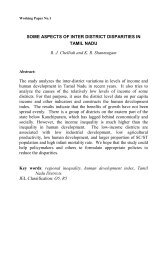
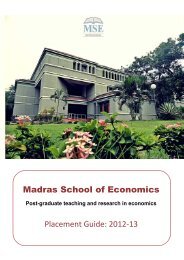
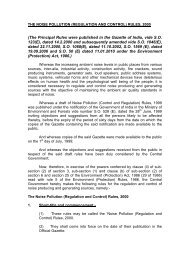
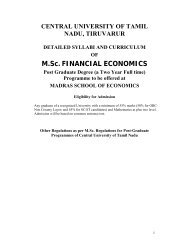
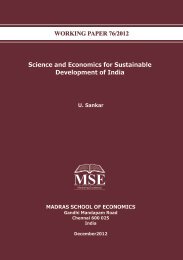
![Curriculum Vitae [pdf] - Madras School of Economics](https://img.yumpu.com/49878970/1/190x245/curriculum-vitae-pdf-madras-school-of-economics.jpg?quality=85)
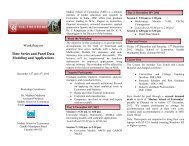
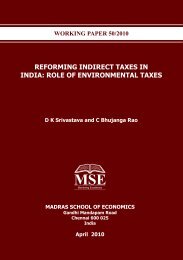
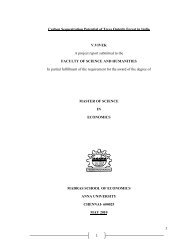
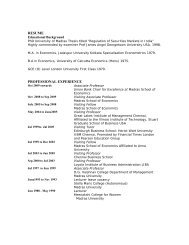
![Curriculum Vitae [pdf] - Madras School of Economics](https://img.yumpu.com/48715201/1/184x260/curriculum-vitae-pdf-madras-school-of-economics.jpg?quality=85)
